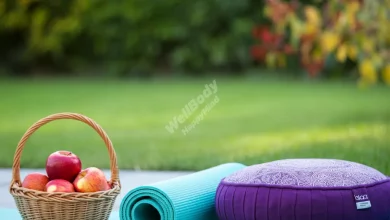Holistic Fitness: Full-Circle Approach to Total Well-Being

Did you know that holistic fitness can boost your exercise commitment? People who use this approach are 30% more likely to stick to their routines long-term. Welcome to the world of holistic fitness! Here, your workout isn’t just about muscles. It’s about nurturing your entire being.
Holistic fitness considers the whole person. It combines physical exercise with mental, emotional, and spiritual well-being. This approach isn’t just about looking good. It’s about feeling great from the inside out. In this guide, you’ll learn how holistic fitness can change your health and happiness.
Understanding the Holistic Fitness Philosophy
Holistic fitness is more than a trend. It’s a lifestyle that can transform your well-being. This philosophy goes beyond physical strength and endurance. It recognizes the connection between body, mind, and spirit. The goal is to create balance in all aspects of life.
Traditional exercise often focuses on physical performance or looks. It might emphasize weight loss, muscle gain, or endurance. These are important, but they’re only part of the picture. A holistic approach offers more.
Holistic fitness considers how movement affects our whole being. It impacts our mental clarity and emotional stability. It can even influence our sense of purpose. This approach turns exercise from a chore into self-care. It nourishes us on multiple levels.
The benefits of holistic fitness are wide-ranging:
- Enhanced overall well-being: It improves physical fitness, mental sharpness, and emotional resilience.
- Sustainable results: When exercise becomes a lifestyle, you maintain gains long-term.
- Reduced stress and anxiety: Holistic practices often include stress-reduction techniques.
- Improved body awareness: You become more attuned to your body’s needs and abilities.
- Increased motivation: Enjoying your routine helps you stay committed.
Research supports the effectiveness of holistic fitness. A study in the Journal of Health Psychology compared different exercise types. It found that mind-body exercises like yoga or tai chi had unique benefits. Practitioners reported higher levels of body awareness and mindfulness. They also experienced greater overall life satisfaction.
The Five Pillars of Holistic Exercise
Holistic fitness is built on five key pillars. Each pillar contributes to your overall well-being. Let’s explore how they work together to create a balanced approach to fitness.
1. Physical Movement
Physical movement is the foundation of any fitness routine. In holistic fitness, we focus on variety and balance. Here’s a quick look at different types of exercises:
| Exercise Type | Benefits | Examples |
|---|---|---|
| Strength | Builds muscle, boosts metabolism | Weight lifting, bodyweight exercises |
| Flexibility | Improves range of motion, reduces injury risk | Yoga, stretching, Pilates |
| Endurance | Enhances cardiovascular health, stamina | Running, cycling, swimming |
Balance is key in holistic fitness. You don’t need to excel in all areas. Instead, aim for a mix that suits your goals and lifestyle. Try different activities to keep things interesting. This variety helps prevent boredom and works different muscle groups.
2. Mental Engagement
Your mind plays a crucial role in holistic fitness. Mental engagement means being present during your workouts. It’s about creating a strong mind-body connection. Here’s how to boost mental engagement:
- Practice mindfulness during exercise
- Set intentions for each workout
- Focus on form and breathing
Mindful movement can turn your workout into a form of moving meditation. Pay attention to how your body feels. Notice the sensations in your muscles. This awareness can help you prevent injuries and enjoy your workouts more.
3. Emotional Balance
Exercise isn’t just good for your body. It’s also a powerful tool for emotional well-being. Regular physical activity can:
- Reduce stress and anxiety
- Boost mood and self-esteem
- Provide an outlet for emotional release
Dr. John Ratey, author of “Spark: The Revolutionary New Science of Exercise and the Brain,” states: “Exercise is the single best thing you can do for your brain in terms of mood, memory, and learning.”
Choose activities that make you feel good. If you’re stressed, a calm yoga session might help. Feeling frustrated? A high-intensity workout could be the perfect release.
4. Spiritual Connection
Spiritual connection in fitness doesn’t necessarily mean religion. It’s about finding meaning and purpose in your movement. Here are some ways to enhance spiritual connection:
- Create a sacred space for your workouts
- Practice gratitude for your body’s abilities
- Connect with nature through outdoor activities
Many people find that outdoor exercise boosts their spiritual connection. A study in Environmental Science & Technology found that exercising in nature improved mood and self-esteem more than indoor workouts.

5. Social Integration
Humans are social creatures. Incorporating social elements into your fitness routine can boost motivation and enjoyment. Benefits of social fitness include:
- Increased accountability
- Shared motivation and support
- Fun and enjoyment in group activities
Join a fitness class, find a workout buddy, or participate in team sports. These social connections can make your fitness journey more enjoyable and sustainable.
By incorporating these five pillars into your fitness routine, you create a holistic approach. This balanced method nurtures your body, mind, and spirit.
Creating Your Holistic Fitness Plan
Developing a holistic fitness plan is an exciting journey. It’s about finding what works best for you. Let’s break down the process into manageable steps.
Step 1: Assess Your Current Fitness Level
Before you start, it’s important to know where you stand. Consider these aspects:
- Physical strength and endurance
- Flexibility and balance
- Mental focus and stress levels
- Emotional well-being
- Social connections in fitness
You don’t need fancy tests. Simple self-assessment can give you a good starting point.
Step 2: Set Multi-Dimensional Goals
Holistic fitness isn’t just about losing weight or building muscle. Set goals that address different aspects of your well-being. For example:
- Physical: “I want to run a 5K in 3 months.”
- Mental: “I aim to practice mindfulness during workouts 3 times a week.”
- Emotional: “I’ll use exercise to manage stress better.”
- Spiritual: “I’ll connect with nature by hiking once a month.”
- Social: “I’ll join a local sports team or fitness class.”
Remember, your goals should be SMART: Specific, Measurable, Achievable, Relevant, and Time-bound.
Step 3: Create a Balanced Weekly Plan
Here’s a sample weekly plan that incorporates all five pillars of holistic fitness:
| Day | Activity | Focus |
|---|---|---|
| Monday | Strength training | Physical, Mental |
| Tuesday | Yoga | Physical, Mental, Spiritual |
| Wednesday | Group fitness class | Physical, Social |
| Thursday | Nature walk | Physical, Emotional, Spiritual |
| Friday | High-intensity interval training | Physical, Emotional |
| Saturday | Team sport or group activity | Physical, Social |
| Sunday | Meditation and gentle stretching | Mental, Emotional, Spiritual |
This plan is just an example. Adjust it to fit your goals and lifestyle.

Step 4: Track Your Progress
Monitoring your progress helps you stay motivated. It also shows you what’s working and what needs adjustment. Consider tracking:
- Physical measurements (if relevant to your goals)
- Energy levels and mood
- Sleep quality
- Stress levels
- Overall sense of well-being
Use a journal, app, or wearable device to keep track. Remember, progress isn’t always linear. Be patient and kind to yourself.
Common Challenges and Solutions
Even with the best plans, challenges can arise. Here are some common issues and how to overcome them:
1. Time Management
Challenge: “I don’t have time for a holistic fitness routine.”
Solution: Start small. Even 10-minute sessions count. Schedule workouts like important appointments. Look for ways to integrate movement into your daily life, like taking stairs instead of elevators.
2. Motivation Issues
Challenge: “I struggle to stay motivated.”
Solution: Set small, achievable goals. Celebrate your wins, no matter how small. Find activities you enjoy. Mix up your routine to prevent boredom. Consider working with a fitness buddy or coach for accountability.
3. Physical Limitations
Challenge: “I have injuries or health issues that limit my activities.”
Solution: Consult with healthcare professionals. They can help you find safe, effective exercises. Focus on what you can do, not what you can’t. Remember, any movement is better than none.
4. Mental Blocks
Challenge: “I feel self-conscious or anxious about exercising.”
Solution: Start in a comfortable environment, like at home. Practice positive self-talk. Remember that everyone starts somewhere. Consider working with a mental health professional to address underlying issues.
By addressing these challenges head-on, you can create a sustainable holistic fitness routine. Remember, the goal is progress, not perfection.
Tools and Resources
The right tools and resources can make your holistic fitness journey smoother and more enjoyable. Here’s a curated list to help you get started:
Equipment Recommendations
- Yoga mat: Great for yoga, stretching, and floor exercises
- Resistance bands: Versatile for strength training at home or while traveling
- Foam roller: Helps with muscle recovery and flexibility
- Meditation cushion: Supports proper posture during meditation sessions
- Fitness tracker: Monitors various aspects of your physical activity and health
Apps and Tracking Devices
- MyFitnessPal: Tracks nutrition and exercise
- Headspace: Offers guided meditations and mindfulness exercises
- Strava: Great for tracking outdoor activities and connecting with others
- Fitbit or Apple Watch: Wearable devices that monitor various health metrics
- Nike Training Club: Provides a variety of workout routines for all levels
Community Resources
- Local fitness centers or YMCA: Offer classes and equipment
- Meetup groups: Find like-minded individuals for group activities
- Online forums: Connect with others on similar fitness journeys
- Local parks and trails: Great for outdoor workouts and connecting with nature
- Community education programs: Often offer affordable fitness and wellness classes

Remember, you don’t need all these tools to start. Begin with what you have and add items as you progress in your journey.
Conclusion
Embarking on a holistic fitness journey is a powerful step towards overall well-being. Let’s recap the key benefits of this approach:
- It addresses all aspects of health: physical, mental, emotional, and spiritual
- Provides sustainable results by making fitness a lifestyle, not just a temporary fix
- Enhances body awareness and self-understanding
- Reduces stress and improves emotional balance
- Increases motivation through varied and enjoyable activities
Now is the perfect time to start your holistic fitness journey. Here’s your call to action:
- Assess your current fitness level across all five pillars
- Set one goal for each pillar of holistic fitness
- Create a simple weekly plan that incorporates different types of activities
- Start small, but start today
Remember, holistic fitness is not about perfection. It’s about progress and balance. Every step you take, no matter how small, is a step towards a healthier, happier you.
As you begin this journey, be patient and kind to yourself. Celebrate your successes, learn from your challenges, and enjoy the process of discovering what works best for you.
Your body, mind, and spirit are interconnected. By nurturing all aspects of your being through holistic fitness, you’re investing in your overall quality of life. So, take that first step today. Your future self will thank you for it!




